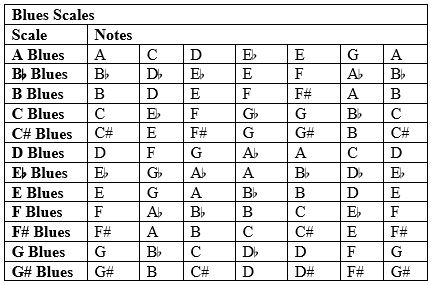Contemporary Music Theory
Pursuing Excellence
Personal Development
Leadership Principles
Administrative Skills
Improvisation - Blues Scales 2

The blues feel is obtained largely by the use of "blue" notes. There are three blue notes; the flattened third, flattened fifth and flattened seventh of the major scale. Thus, in the key of C, the blue notes are E♭, G♭ and B♭. You will see from the following that E♭ and B♭ are both contained in the CmP scale:
If we now add the G♭ to the pentatonic scale, we end up with the six-note blues scale:
Blues scales can be used in most places where a minor pentatonic scale would be suitable. Here is a table showing the notes of the blues scales:
If you look briefly at the notes in the E♭ blues and the F blues, you will notice that the added (flattened fifth) notes were A and B respectively. Strictly speaking, the notes should have been named B♭♭ (B double flat) and C♭, but to avoid confusion, I have used the enharmonic equivalents. As you will remember, an enharmonic equivalent is where a note has more than one name, for instance, F# is the same as G♭; they are enharmonic equivalents.
For information on the various modal scales, diminished scales, half diminished scales and the whole tone scales and how to use them, buy Contemporary Music Theory. (This link will take you to Createspace.com, a subsidiary of Amazon.)
Understanding Scales | Understanding Chord Structure | Understanding Diatonic Chords | Understanding Minor Scales | Diatonic Chords in Minor Keys | Scale Degree Names | Chord Substitution - Extended Chords | Chord Substitution - Overlapping Chords | Improvisation - Arpeggios | Improvisation - Major Scales | Improvisation - Pentatonic Scales | Improvisation - Blues Scales



